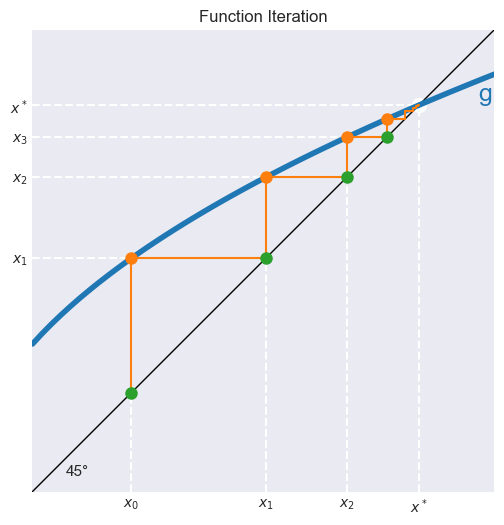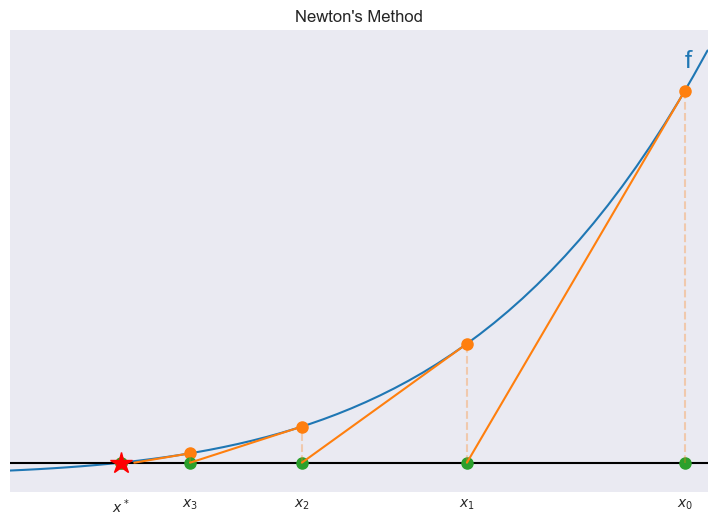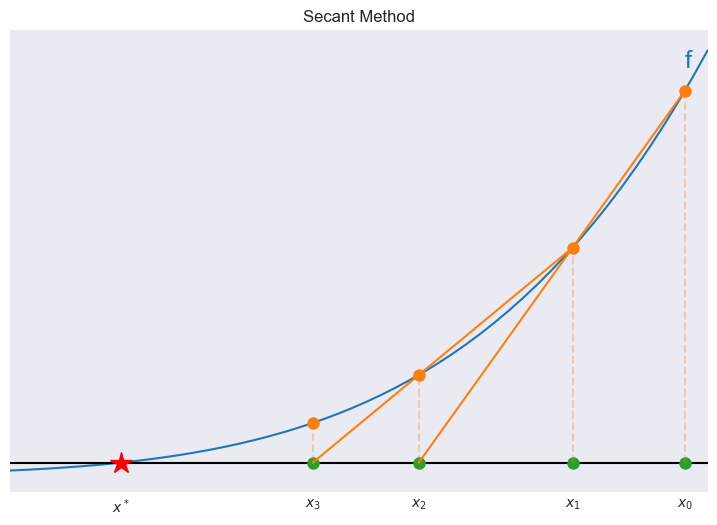Illustrates function iteration, Newton, and secant methods
Contents
Illustrates function iteration, Newton, and secant methods¶
Randall Romero Aguilar, PhD
This demo is based on the original Matlab demo accompanying the Computational Economics and Finance 2001 textbook by Mario Miranda and Paul Fackler.
Original (Matlab) CompEcon file: demslv06.m
Running this file requires the Python version of CompEcon. This can be installed with pip by running
!pip install compecon --upgrade
Last updated: 2022-Sept-04
import numpy as np
import matplotlib.pyplot as plt
plt.style.use('seaborn-dark')
bullet_options = dict(ms=16, marker='.', ls='')
Function Iteration¶
def g(x):
return (x + 0.2)**0.5
xmin, xmax = 0.0, 1.4
xinit, xstar = 0.3, 0.5*(1 + np.sqrt(1.8))
xx = np.linspace(xmin,xmax)
yy = g(xx)
n = 21
z = np.zeros(n)
z[0] = xinit
for k in range(n-1):
z[k+1] = g(z[k])
x, y = z[:-1], z[1:]
xticks = x[:3].tolist() + [xstar]
yticks = y[:3].tolist() + [xstar]
fig1, ax = plt.subplots(figsize=[6,6])
ax.set(
aspect=1.0,
title='Function Iteration',
xlim=[xmin,xmax],
ylim=[xmin,xmax],
xticks=xticks,
xticklabels=['$x_0$', '$x_1$', '$x_2$', '$x^*$'],
yticks=yticks,
yticklabels=['$x_1$', '$x_2$', '$x_3$', '$x^*$']
)
ax.vlines(xticks, xmin, xticks, colors='white', linestyles='--')
ax.hlines(yticks, xmin, yticks, colors='white', linestyles='--')
ax.plot(xstar,xstar,color='white', marker='.', ms=20)
ax.plot(xx,xx,'k-', linewidth=1)
ax.plot(xx,yy,linewidth=4)
ax.step(x,x,'C1')
ax.plot(x[:4], x[:4], color='C2', **bullet_options)
ax.plot(x[:4], y[:4], color='C1', **bullet_options)
ax.annotate('45°', [xmin+0.1,xmin+0.05], ha='left', fontsize=11)
ax.annotate('g', [xmax-0.05, g(xmax)-0.08], ha='left',fontsize=18, color='C0');

Newton’s Method¶
def f(x):
return x**5 - 3, 5*x**4
xmin, xmax = 1.0, 2.55
xinit, xstar = xmax-0.05, 3**(1/5)
xx = np.linspace(xmin, xmax)
yy, dyy = f(xx)
n = 5
x, y = np.zeros(n), np.zeros(n)
x[0] = xinit
for k in range(n-1):
y[k], dlag = f(x[k])
x[k+1] = x[k] - y[k]/dlag
xticks = np.array(x[:4].tolist() + [xstar])
fig2, ax = plt.subplots(figsize=[9,6])
ax.set(
title="Newton's Method",
xlim=[xmin,xmax],
xticks=xticks,
xticklabels= ['$x_0$', '$x_1$', '$x_2$','$x_3$', '$x^*$'],
yticks=[]
)
ax.plot(xx,yy)
ax.axhline(0, color='k')
ax.annotate('f',[xinit,f(xinit+0.03)[0]], fontsize=18, color='C0')
ax.plot(xticks, f(xticks)[0], color='C1', **bullet_options)
ax.plot(xticks, 0*xticks, color='C2', **bullet_options)
ax.plot(xstar, 0, color='r', marker='*', ms=16)
for xi,xinext,yi in zip(x,x[1:],y):
ax.vlines(xi,0, yi,colors='C1', linestyle='--', alpha=0.3)
ax.plot([xi,xinext],[yi, 0], color='C1')

Secant Method¶
from turtle import title
def f(x):
return x**5 - 3
xmin, xmax = 1.0, 2.55
xinit, xstar = xmax-0.05, 3**(1/5)
xx = np.linspace(xmin, xmax)
yy = f(xx)
n = 4
x = np.zeros(n)
x[:2] = xinit, xinit-0.25
y = f(x)
for i in range(2,n):
x[i] = x[i-1] - y[i-1]*(x[i-1]-x[i-2]) / (y[i-1]-y[i-2])
y[i] = f(x[i])
xticks=np.array(x[:4].tolist() + [xstar])
fig3, ax = plt.subplots(figsize=[9,6])
ax.set(
title="Secant Method",
xlim=[xmin,xmax],
xticks=xticks,
xticklabels=['$x_0$', '$x_1$', '$x_2$','$x_3$', '$x^*$'],
yticks=[]
)
ax.plot(xx,yy)
ax.axhline(0, color='k')
ax.annotate('f', [xinit,f(xinit+0.03)], fontsize=18,color='C0')
ax.plot(x, y, color='C1', **bullet_options)
ax.plot(x, 0*y, color='C2', **bullet_options)
ax.vlines(x, 0, y, colors='C1', linestyles='--', alpha=0.3)
for xi,xinext,yi in zip(x,x[2:],y):
ax.plot([xi,xinext],[yi, 0], color='C1')
ax.plot(xstar, 0, color='red', marker='*', ms=16)
[<matplotlib.lines.Line2D at 0x1a6f6837460>]

